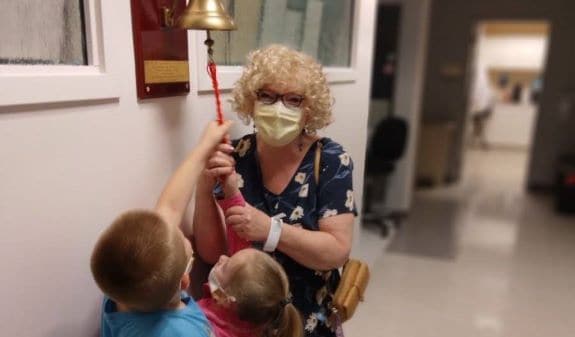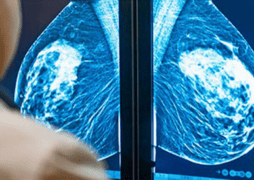For many years, breast density (a measure that compares the amount of fat and tissue in the breast) was one of the most important breast cancer risk factors that few people had ever heard of. While it was well known among researchers, the term wasn’t used much in routine health care. That is now changing.
Several large patient advocacy organizations, including Komen, now support proposed federal legislation that would require providers and patients to be notified of a patient’s breast density by those performing mammograms. This legislation would encourage increased communication between patients and their health care providers once a patient’s breast density has been determined. The bill would also require increased federal investment for research into breast density.
“Currently, there is no federal standard requiring women to be informed if they have dense breast tissue, which could really impact how women make informed choices with their providers about breast cancer screening, states Kimberly Beer, Director of Public Policy at Komen. “Knowledge is power and women deserve to know and understand all of their risk factors. “
Unfortunately, while we know more than ever about the risks that high breast density poses, questions remain about what exactly to do with this information. And, at this time there are no special breast cancer screening recommendations for women with dense breasts.
So what is breast density?
Breast density is a measure that compares the amount of fat and the amount of tissue that make up the breast. Less dense breasts have more fat and less tissue. More dense breasts have more tissue and less fat.
How is breast density determined?
Breast density is determined from a mammogram that is assessed by a radiologist. It is not related to the firmness of the breast and cannot be determined from a doctor’s exam.
As mentioned above, some mammogram reports may include a woman’s breast density. When it is listed on a mammogram report, it will sometimes be described with a four-category scale from A to D – with A being least dense breasts (mostly fat) and D being most dense breast (mostly tissue). Women considered to have “dense breasts” typically fall into the C and D categories.
Other mammogram reports and patient notification letters may only note if a woman has dense breasts, without listing a specific category.
What percentage of women have dense breasts?
High breast density is common. Between 40 and 50 percent of women aged 40 to 74 in the U.S. have dense breasts.1-2
Breast density varies greatly by age and weight though. Dense breasts are more common in both young and thin women.
- About 50 to 60 percent of women ages 40 to 44 have dense breasts, while the rate is around 20 to 30 percent in those ages 70 to 74.1-2
- In healthy weight women, 50 to 60 percent have dense breasts, while in obese women, around 20 to 30 percent do.1-2
What affects breast density?
Besides age and weight, other factors related to high breast density include:3-5
- genetics and family history
- menopausal hormone therapy use
- having fewer children
Does having dense breasts increase breast cancer risk?
Studies have found that women with high breast density have about a four to five times higher risk of breast cancer than women with low breast density.1,6 This makes breast density a stronger breast cancer risk factor than many other factors known to increase risk.
However, it is not really understood why breast density increases risk. We also don’t know if there are any steps that women can take to lower the risk related to high breast density.
Does having dense breasts change how a woman should be screened?
One concern with breast cancer screening in women with dense breasts is that some tumors may not show up well on mammograms. Dense breast tissue and tumors can both appear as white. This can make it hard to distinguish one from the other. The denser the breast, the harder it can be to find tumors.
So, adding tests, such as breast ultrasound and breast MRI to mammography, has been proposed as a way to screen women with dense breasts. These tests may be better able to distinguish tumors from normal tissue and may catch cancers that could be missed with mammography.7
Unfortunately, there is no convincing evidence that adding these tests for women with dense breasts would save more lives than screening with mammography alone. And, more testing is likely to come with burdens, such as a high number of unnecessary biopsies.8
Tailoring additional screening to only women with very dense breasts or who are also at high risk of breast cancer based on other factors could reduce burdens and improve benefits, but more research is needed.1,9
Women who have questions about their breast density, and how it might affect their breast cancer risk and screening, should talk with their doctors. Together, they can decide if further screening makes sense.
Summary
Breast density is an important breast cancer risk factor that can also affect the ability of mammograms to detect some tumors. However, there is currently no convincing evidence that screening with breast ultrasound or breast MRI provide added benefits to women with dense breasts. Doctors remain the best source of information about breast density and how it may affect breast cancer risk and screening.
What is Komen doing?
Komen has invested more than $19 million in research focused on breast density, including:
- Determining how breast density contributes to increased breast cancer risk
- Identifying the biological, behavioral and social factors that may affect breast density such as environmental chemicals, diet, obesity and other lifestyle factors
- Developing methods to better screen for and detect breast cancer in women with dense breasts, including ultrasound tomography and low-dose molecular breast imaging
Aside from funding research, we also support the enactment of the Breast Density and Mammography Reporting Act of 2015.
Komen educational resources
- Facts For Life: Breast Density
- Breast density and mammography
- Breast density and breast cancer risk
- Questions To Ask Your Doctor: Breast Density
References
- Ho JM, Jafferjee N, Covarrubias GM, Ghesani M, Handler B. Dense breasts: a review of reporting legislation and available supplemental screening options. AJR Am J Roentgenol. 203(2):449-56, 2014.
- Sprague BL, Gangnon RE, Burt V, et al. Prevalence of mammographically dense breasts in the United States. J Natl Cancer Inst. 106(10), 2014.
- Venkataraman S, Slanetz TJ. Breast imaging for cancer screening: Mammography and ultrasonography, in UpToDate (Elmore JG, Sokol HN, eds.]. www.uptodate.com/contents/breast-imaging-for-cancer-screening-mammography-and-ultrasonography, 2015.
- Boyd NF, Dite GS, Stone J, et al. Heritability of mammographic density, a risk factor for breast cancer. N Engl J Med. 347(12):886-94, 2002.
- Stomper PC, D’Souza DJ, DiNitto PA, Arredondo MA. Analysis of parenchymal density on mammograms in 1353 women 25-79 years old. AJR Am J Roentgenol. 167(5):1261-5, 1996.
- Boyd NF, Guo H, Martin LJ, et al. Mammographic density and the risk and detection of breast cancer. N Engl J Med. 356(3):227-36, 2007.
- Berg WA, Zhang Z, Lehrer D, et al. for the ACRIN 6666 Investigators. Detection of breast cancer with addition of annual screening ultrasound or a single screening MRI to mammography in women with elevated breast cancer risk. JAMA. 307(13):1394-404, 2012.
- Sprague BL, Stout NK, Schechter C, et al. Benefits, harms, and cost-effectiveness of supplemental ultrasonography screening for women with dense breasts. Ann Intern Med. 162(3):157-66, 2015.
- Kerlikowske K, Zhu W, Tosteson AN, et al. Identifying women with dense breasts at high risk for interval cancer: a cohort study. Ann Intern Med. 162(10):673-81, 2015.




